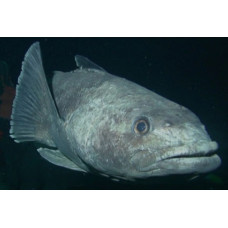Latin name
Dissostichus mawsoni
Other names
Antarctic cod
Identification
First dorsal fin with 7-9 barb rays, second dorsal fin with 24-27 barb rays, anal fin with 25-28 barb rays, pectoral fin with 26-29 rays, dorsal (upper) lateral line with 92-97 tubular scales, medial (middle) lateral line with 35-48 tubular scales, total number of gill stamens in the outer row on the first gill arch with 15-18, of which 3-5 stamens in the upper part of the arch and 10-15 in the lower part. The scales on the body are small, cycloid, except for the areas of the body covered by the spread pectoral fins, which have ctenoid scales. The head is also largely covered with scales, except for the completely bare snout and lower jaw. The caudal fin is truncated or somewhat notched. The overall colouration of the adult body is very variable, ranging from grey to brown and sometimes almost black. The sides of the body have irregular dark patches or broad horizontal stripes. Small immature specimens inhabiting the shallow shelf have a characteristic yellowish or greyish body colour with highly contrasting dark, sometimes almost black, vertical stripes on the sides.
Distribution
It has a circumpolar-antarctic distribution in the high latitudes of the Southern Ocean south of 55-60°S. Juveniles inhabit shallow water on the Antarctic shelf, close to maturity, and mature individuals migrate to the deep bathyal zone, where they are found near the bottom at depths of up to 1,500-2,250 metres.
Habitat
Antarctic endemic. It is found in the high latitudes of the Southern Ocean and is known to occur at depths of 2200m.
Size
Reaches a total length of 199 cm and a weight of up to 135 kg, usually not exceeding 170 cm and weighing up to 70 kg. Modal sizes in various deep-sea fisheries range from 132 to 162 cm with an average weight of 28 to 53 kg.
Life history and Behavior
The spawning season is considerably longer and takes place in the autumn-winter period from March to August. Life expectancy - up to 39 years, according to some authors up to 48 years.
Food and feeding habits
Predatory species, feeding on a wide variety of animal food - octopus, squid, fish and various carrion sinking to the bottom from the higher horizons of the pelagial. Among the fish Macrourus, Chionobathyscus (Chionobathyscus dewitti), Artedidraconidae of the genus Pogonophryne and sometimes Chionodraco chamatus are usually present, among the squids - Psychroteuthis glacialis and Colossal squid (Mesonychoteuthis hamiltoni).
Reproduction
Sexual maturity does not occur until fish reach a total length of 95-105 cm at the age of 8-9 years. According to some data, males become sexually mature at about 13 years of age and females at about 17 years of age. Absolute fecundity is 0.87-1.40 million eggs (average 1.00 million), relative fecundity is 13-46.5 eggs/g (average 25 eggs/g).
| Classification | |
| Phylum | Chordata |
| Class | Actinopterygii |
| Squad | Perciformes |
| Family | Nototheniidae |
| Genus | Dissostichus |
| Species | D. mawsoni |
| Features | |
| Conservation status | No information |
| Habitat | Pelagic |
| Life span, years | 48 |
| Maximum body weight, kg | 135 |
| Maximum length, cm | 199 |
| Sailing speed, m/s | No information |
| Threat to people | Edible |
| Way of eating | Predator |
Antarctic toothfish
Tags: antarctic toothfish


